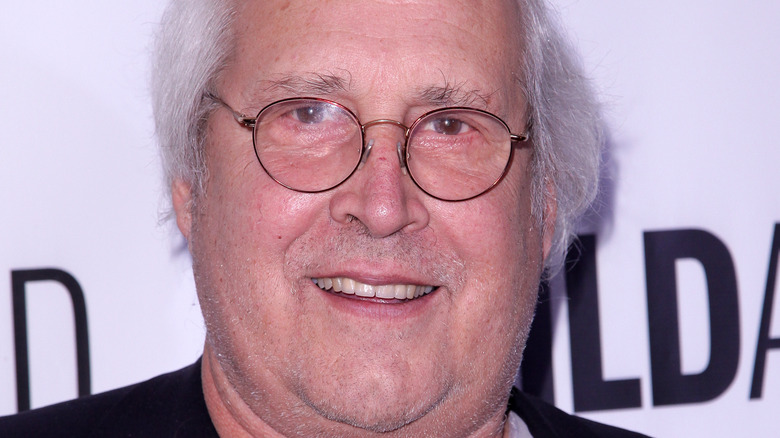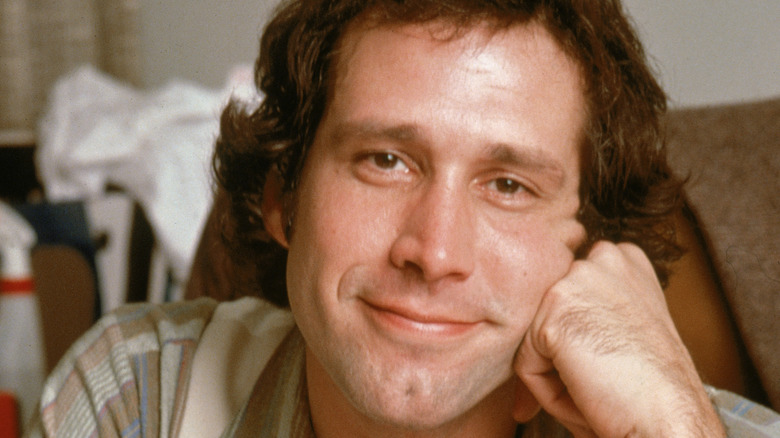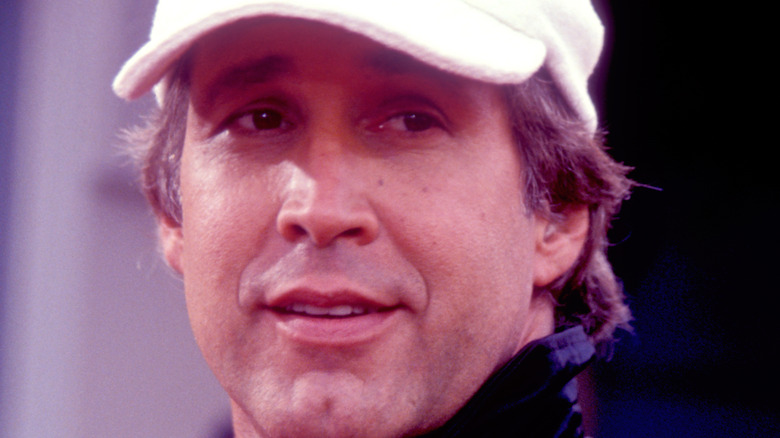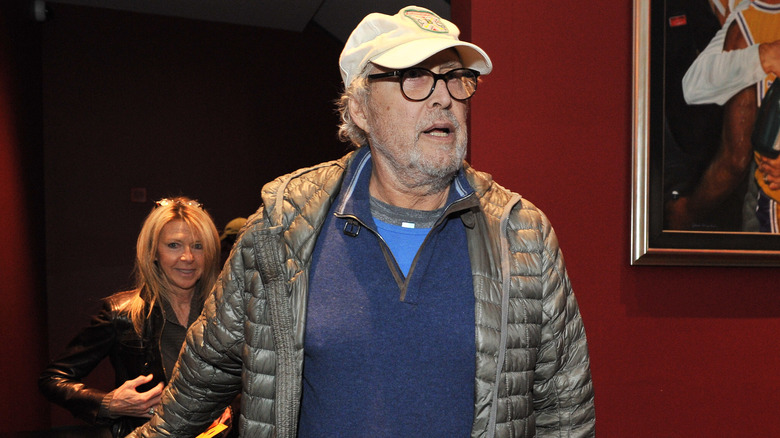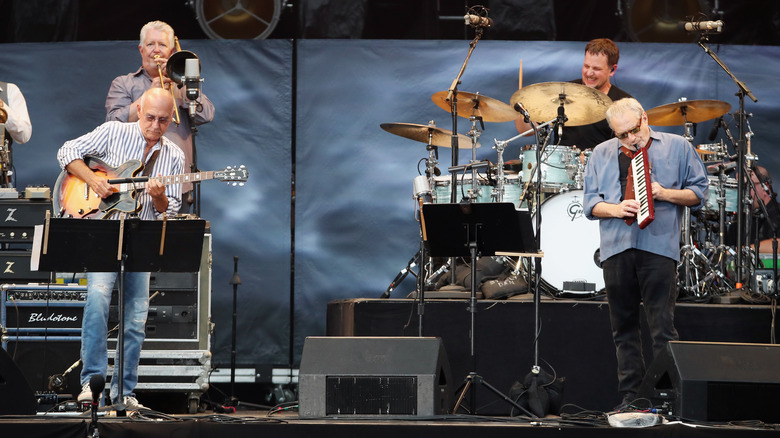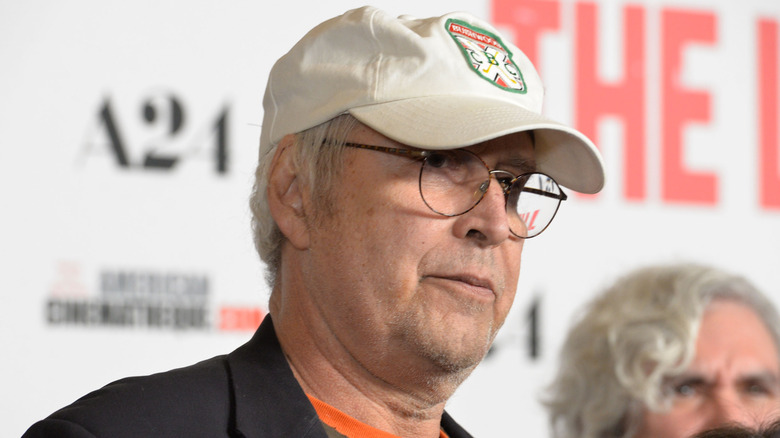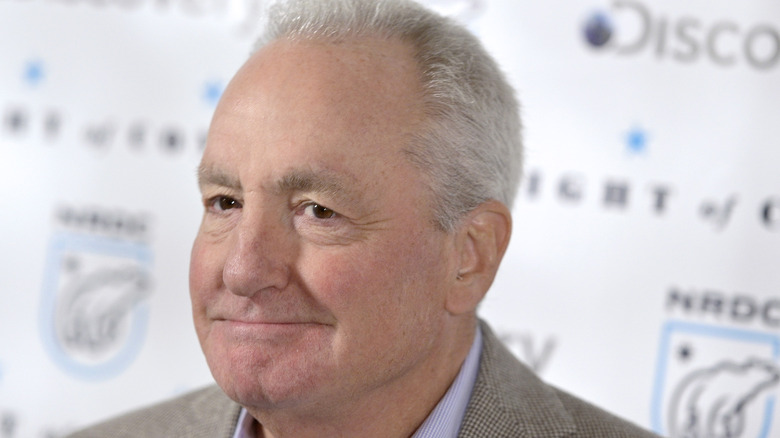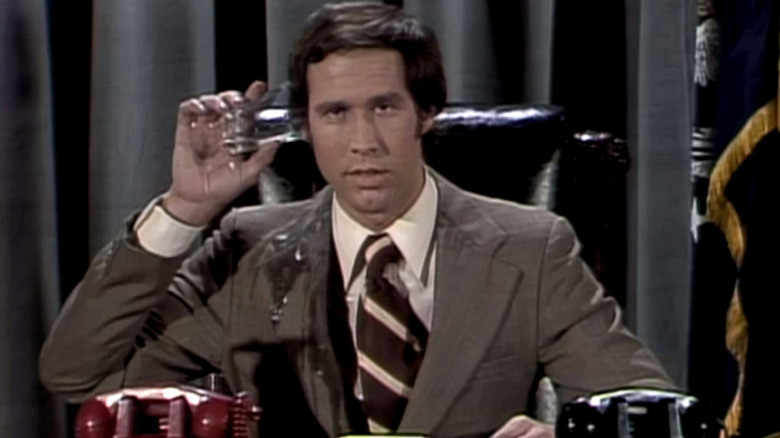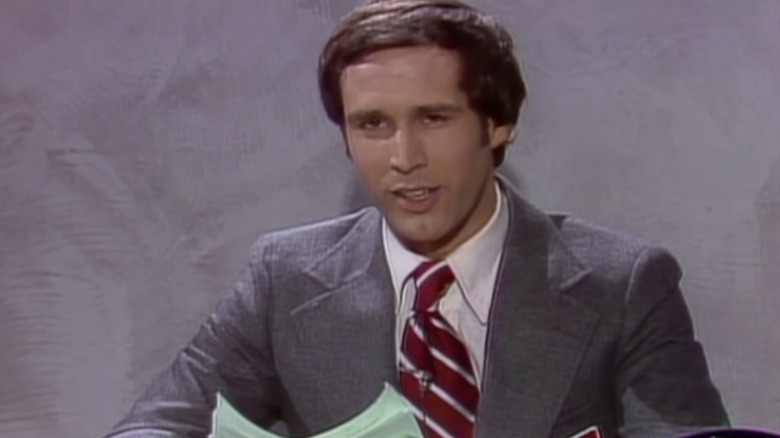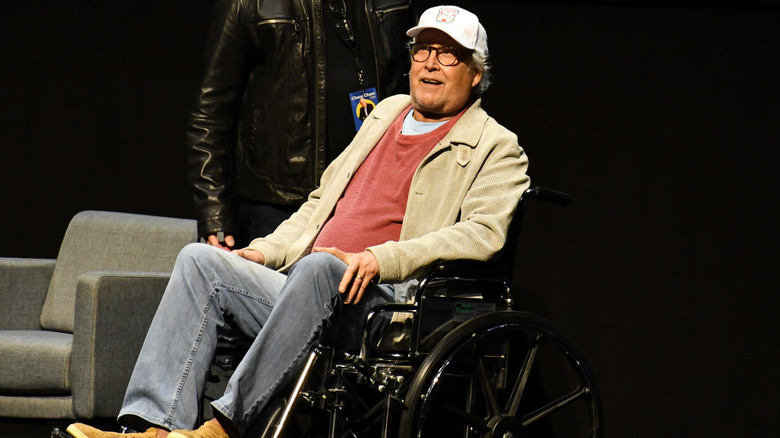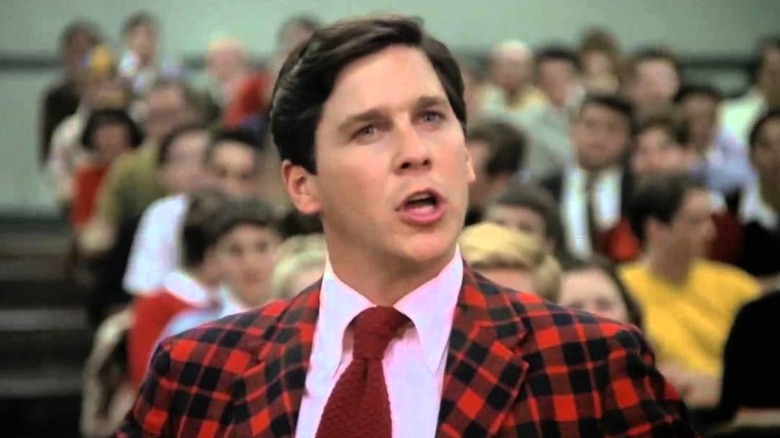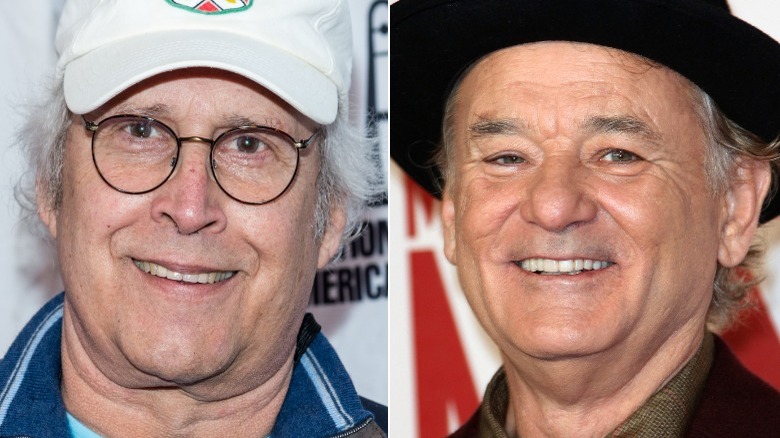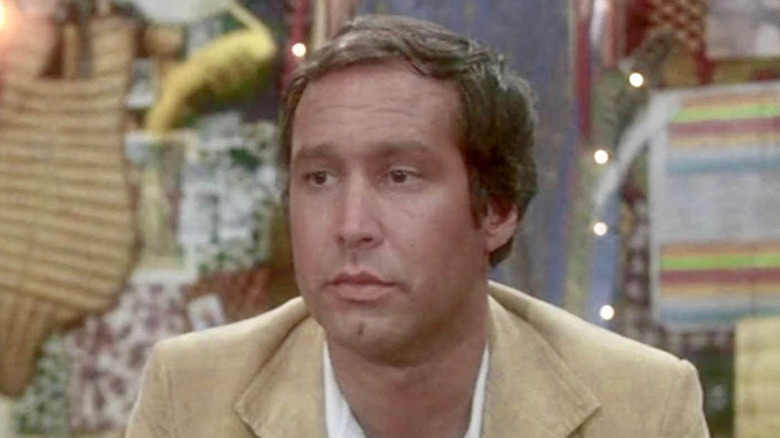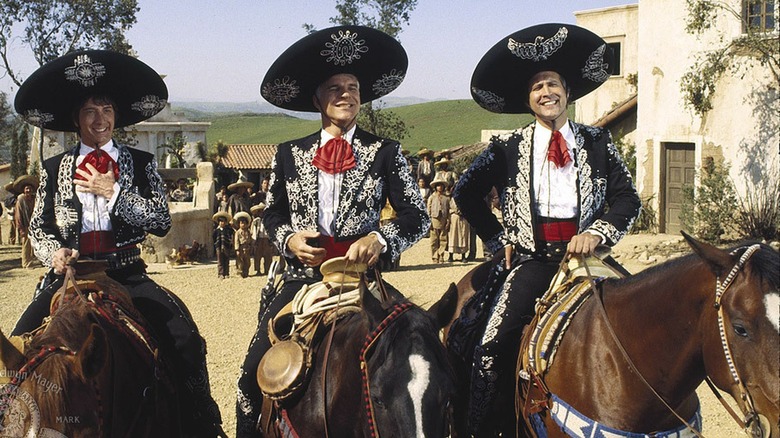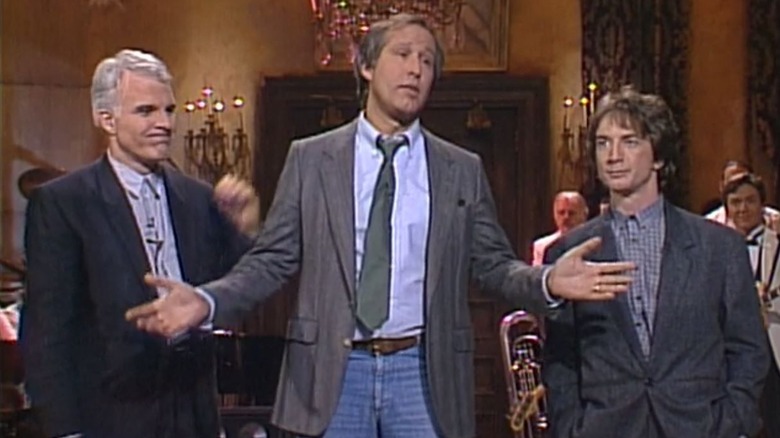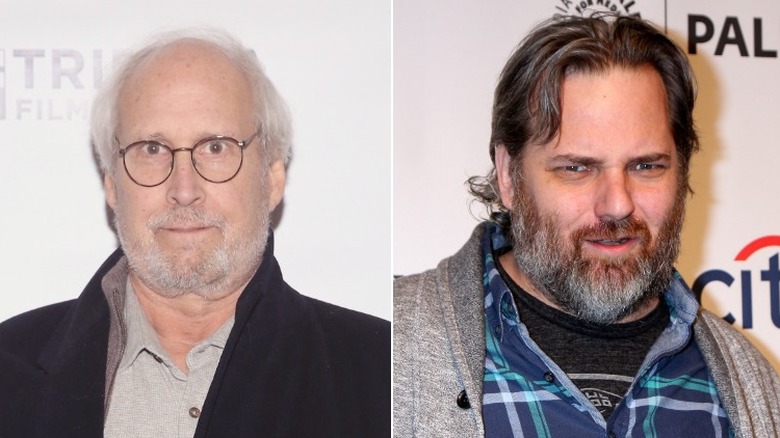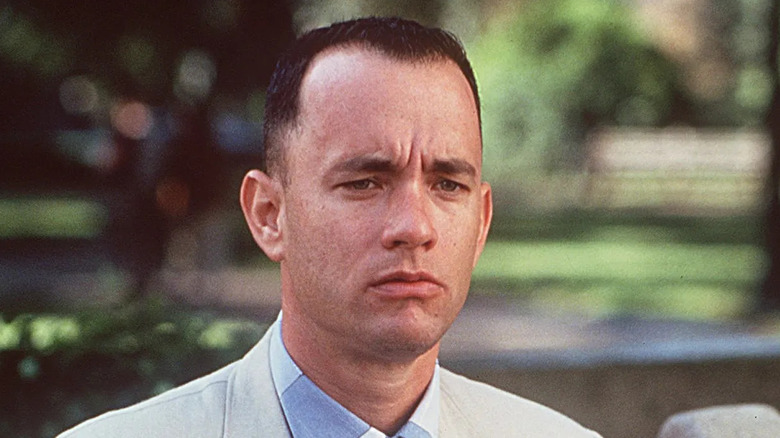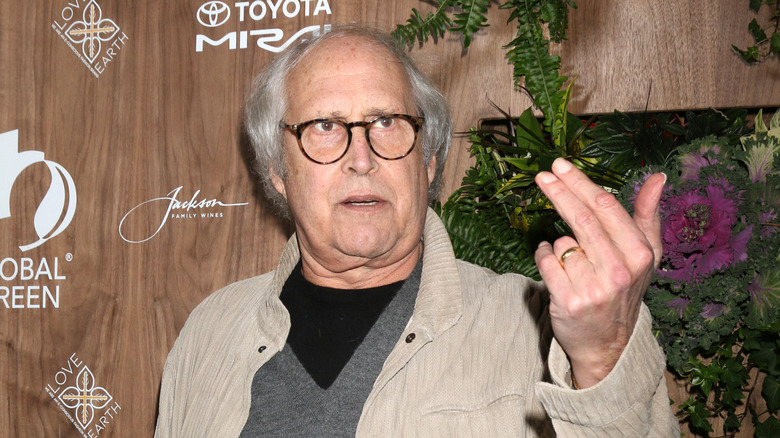The Untold Truth Of Chevy Chase
Chevy Chase has lived a career most aspiring comedians would envy. Receiving his start as an original cast member on "Saturday Night Live," Chase soon became the first breakout star of the legendary sketch series, thanks largely to his time on Weekend Update — a program he helped co-create (via Biography.com).
Following his departure from "SNL" in 1976, Chase went on to headline several critically and financially successful films, including classic 1980s hits like "Caddyshack," "Fletch," "Three Amigos," and several "National Lampoon's Vacation" films. Later in life, following a period of inactivity, Chase reemerged in the public spotlight thanks to a starring role in NBC's sitcom "Community," which earned renewed success for the older Chase.
As eventful as Chase's career has been, the star has not been without his fair share of scandal and controversy, and has cultivated a negative reputation due to his allegedly poor treatment of fellow cast and crew members. Since his time on "SNL," in fact, several people — including directors, stars, and fellow "SNL" cast mates — have come forward to speak about Chase's reportedly horrible treatment of them in the past.
Not surprisingly, Chase's life and decades-long career has been filled with ups and downs, so here are some little-known facts about this famous pioneer of Weekend Update. Ranging from his upbringing to his start in comedy to his most heated rivalries, read on to discover the untold truth of Chevy Chase.
He comes from an extremely wealthy family
Chase was born in Lower Manhattan in 1943 to an incredibly wealthy, artistic family, as reported by New York Magazine. His mother Cathalene was the stepdaughter of Cornelius Vanderbilt Crane, who was the heir to Crane Holdings, an industrial company founded in 1855. Cathalene was also a successful concert pianist and librettist, while Chase's father, Edward Tinsley ("Ned") Chase, was a Princeton alumnus, who worked as an editor and writer.
Chase's parents divorced when he was 4-years-old, and his father then married Lyn Atha, the heiress to the Folgers coffee company, while his mother married the psychiatrist John Cederquist. Despite his wealthy upbringing, however, Chase told New York Magazine that he always felt alienated due to the high social standing of his family members because he never believed that he belonged.
According to Chase's authorized biography "I'm Chevy Chase ... And You're Not," written by Rena Fruchter, his mother and his new stepfather regularly subjected him to "emotional and physical abuse that sometimes bordered on torture," as reported in Reuters. As a result of his allegedly poor treatment at his parents' hands, Chase grew up feeling embittered towards his mother and stepfather, and held a grudge against them even following both of their deaths. "I'll never forgive them," he says in his book. "At their graves I didn't. It was too hard for me. You would think a grown man could shake it off, as the coffin was lowered, to say, 'I forgive you.' I don't forgive."
He may have been named after a medieval English ballad
It's hard to believe, but Chevy Chase wasn't always Chevy Chase. In reality, his legal birth name is Cornelius Crane Chase, which is taken from his maternal step-grandfather's name. According to his biography "I'm Chevy Chase ... and You're Not," when Chase was just 2-years-old, his paternal grandmother gave him the nickname "Chevy." Chase has not been able to confirm where exactly the nickname came from, but one theory is that his grandmother plucked it from the medieval English ballad, "The Ballad of Chevy Chase." The ballad was written in the 15th century and a second ballad was added sometime in the 17th century, as speculated by Luminarium: Anthology of English Literature.
The song lyrics focus on the historical 1388 Battle of Otterburn, which erupted when an English hunting party led by Sir Henry "Hotspur" Percy entered the Scottish hunting grounds (chase) in the nearby Chevriot Hills (resulting in the term "Chevy Chase"). According to the American Antiquarian Society, when the Scottish Earl of Douglas heard about this, he gathered a force to defend his lands, leading to a skirmish that claimed most of the lives of both armies. The Scottish ultimately emerged victorious, though the conflict ended up costing Douglas his life.
It's unclear why Chase's grandmother would have pulled his nickname from this balled, and as Chase quips in his biography, she might have just named him after Chevy Chase, Maryland. Either way, he adopted it as his stage name when he set out to pursue a career in entertainment.
He was stabbed three times during a boyhood fight
Though Chase came from a very well-off family, his childhood years in New York City were marred by fights with other neighborhood kids. "In the fifties, you couldn't walk by another guy without staring at him and him staring at you the whole time — it was a 'I'm more of a man and tougher than you' thing," he wrote in an essay for New York Magazine in 2013.
He routinely fought local boys whenever he ventured into Harlem on an errand for his parents. During one particular trip to a grocery store, three boys around Chase's age began harassing him, and one of them punched Chase in the face repeatedly. "I came back from the grocery store with a bloody nose, and my mother sent me back for something else!" Chase wrote.
When he returned to the store, he once again encountered the same three boys. "When we got to the corner, I'd had it. I just took the little kid out, and of course the other two, the big ones, jumped me," said Chase. When he was running away from the fight, Chase said that one of the boys stabbed him in the back three times after the brawl was over. "I still have these knife-wound scars," Chase reminisced. Later, Chase began using roller skates to quickly get around town and avoid future run-ins with any would-be attackers. "I must have known every alleyway, every possible place you could either hide or cause trouble from up in the Nineties to Grand Central," wrote Chase.
He was in a college band with the founding members of Steely Dan
After graduating in 1962 from the Stockbridge School — an independent boarding school in western Massachusetts — Chase briefly enrolled in Haverford College from 1962 to 1963. In an interview with The Today Show, Chase claimed that he was expelled from Haverford for bringing a cow to an upper floor of his residential building (via Haverblog). He then transferred to the pre-med program at Bard College, but he switched his major and graduated in 1967 with a Bachelor of Arts in English instead.
According to Far Out Magazine, Chase began focusing on his musical interests while at Bard. He formed a few short-lived bands, including one called The Leather Canary. The band was comprised of Chase and his college friends, Walter Becker and Donald Fagen, who later went on to be two of the founding members of the classic rock band Steely Dan.
Described by Chase as "a bad jazz band," The Leather Canary only lasted for a short time, but left a lasting impression on Becker and Fagen. "We went to college with Chevy and before we ever thought of the idea of Steely Dan we used to do pickup dates with Chevy on drums. He was a very good drummer." Chase explored his musical talents for a little while longer, as he played for the psychedelic rock band Chamaeleon Church and even recorded an album with them, before switching to comedy and acting.
He successfully dodged the Vietnam War draft
During Chase's final years in college, the United States' involvement in the Vietnam War intensified and military drafts were instated around the country. While he was exempt from military service so long as he was in school, Chase knew that the moment he graduated, he was going to be sent to Vietnam. "I was still in college and I had to wait another year, and then I knew, that was it. I was going in," Chase explained on "The Pat Sajak Show" in 1989.
Chase elaborated on how he successfully managed to dodge the military draft, as well as why he wanted to avoid service in the first place. "I thought, this was not a war that I agree with — which I didn't and many of us didn't at the time — and at the time I felt, 'No, I don't want to support this, and I certainly don't want to get blown up,'" said Chase.
Chase said he lied on his application form for military eligibility, claiming that he regularly had instances of "headaches, bedwetting, and homosexual tendencies" (which, at the time, disqualified young men from serving in the military). To further sell the idea that he was unfit for service, Chase didn't sleep for two days (drinking only coffee to stay awake), put an entire tube of gel in his hair, and did not shower, "so it was not a pretty sight." The draft board promptly issued Chase a 4-F Classification, allowing him to avoid being drafted. Although, as Chase told Sajak, he wasn't proud of the incident.
He met SNL producer Lorne Michaels while in line for a Monty Python film
After graduating college, Chase worked various odd jobs, while searching for a way to break into the entertainment industry (via Far Out Magazine). According to his biography "I'm Chevy Chase ... and You're Not," by the early 1970s, Chase had begun writing steadily for publications like the National Lampoon and Mad Magazine, as well as writing and performing for "The National Lampoon Radio Hour." The turning point of Chase's career, however, came in a wholly unexpected manner.
The fateful night occurred when Chase and a group of friends went to see a midnight showing of 1975's "Monty Python and the Holy Grail," as Chase told the Orlando Sentinel in 1989. To kill time while waiting in line, Chase began joking around with his friends, which caught the attention of Lorne Michaels, the creator and executive producer of "SNL," who was also waiting in line. "He saw me on line being funny, apparently, and he was looking for writers for this new show and he offered me a job," said Chase.
Originally, Chase was meant to serve strictly as a writer but before long, though, Chase also found himself performing sketches in front of the camera. As Michaels told New York Magazine in 1975, "after two or three days I knew he'd be in the repertory company. The network was opposed to it, but I went with my instincts that Chevy was one of the funniest people I'd ever seen." The rest, as they say, is history.
He was the first breakout star of SNL
When "SNL" first aired in 1975, critics and audience members quickly singled out Chevy Chase as one of the show's major highlights. Doug Hill and Jeff Weingrad wrote in "Saturday Night: A Backstage History of Saturday Night Live" that "There were many who would come to think 'Saturday Night' in the first season was the Chevy Chase Show" (via Grantland). NBC executives immediately took notice of Chase's talent, with network publicist Les Slater calling Chase "one of the faces more readily identified with the show" just two weeks after the premiere of "SNL." Thanks to popular recurring segments like Weekend Update, Chase received more and more exposure each week he appeared on "SNL." "You can't imagine the beginnings of 'Saturday Night Live' without Chevy," Lorne Michaels told Entertainment Weekly. "He was the absolute center of the show."
As a result, Chase has been described by numerous publications like Entertainment Weekly and Insider as "the first breakout star" in "SNL" history, setting a standard for every major talent that followed him on the series. However, despite becoming one of the most recognizable talents on "SNL" in its first 2 seasons, Chase decided to leave the show in late 1976 in the middle of the second season. He became the first original cast member to leave the show — a decision he told The Washington Post he regretted. He was promptly replaced by Bill Murray following his departure from the second season onwards.
NBC originally slated him to succeed Johnny Carson on The Tonight Show
From the moment Chevy Chase appeared on "SNL," NBC took notice of how much viewers loved him. The network quickly began figuring out how to best use Chase's newfound star power for their own benefit. New York Magazine's 1975 cover story on Chase noted that NBC had begun negotiations with Chase to guest host Johnny Carson's "The Tonight Show." NBC described Chase as "the first real potential successor to Johnny Carson" and The New York Magazine article ended with the declaration that Chase was the "heir apparent to Johnny Carson."
For unspecified reasons, the idea was never realized. In a 1976 interview with Tom Shales at The Washington Post, however, Carson remarked that Chase "couldn't ad lib a fart at a bean-eating contest," after witnessing Chase and other "SNL" cast members struggle to fill the space one night when the show ran short (via Roger Ebert). According to "Saturday Night," Chase himself had said he would "never be tied down for five years interviewing TV personalities," so it's fair to believe that the two men didn't see eye-to-eye about Chase being Carson's successor (via Grantland).
However, Salon points out the affair was referred in a particularly tense exchange between Richard Pryor and Chase on "The Tonight Show." After Chase made a tasteless joke about Pryor's son, Pryor said to Chase, "Why didn't you tell Johnny you were going to take over his show?" A flustered Chase then answered, "I knew you'd bring that up, and Johnny and I, we've discussed it, and neither of us cares."
He suffered several injuries from his numerous pratfalls on SNL
A common element of Chase's comedic repertoire is his penchant for physical comedy. Known slapstick comedic style, Chase routinely found himself stumbling around in numerous "SNL" sketches (especially those where he impersonated then-President Gerald Ford), bumping into walls and furniture and almost always toppling over onto the ground.
As hilarious as these pratfalls were, they came at a very serious cost for Chase, both at the time and in his later years. For example, during the premiere of Season 2 of "SNL," Chase injured himself while performing as Ford in a 1976 Presidential debate sketch. Crashing into an unpadded podium, Chase suffered a groin injury that kept him off the show for two weeks (via SFGATE).
Over time, the large number of pratfalls Chase took on "SNL" eventually caused intense damage to his body, and he began taking prescription pain medications to cope, as reported by The New York Times. Unfortunately, this prescription drug use escalated into a full-blown substance abuse issue for several years. Eventually, Chase checked into a rehab facility for treatment in 1986 for ”dependency on prescription drugs relating to chronic and long-term back problems” according to his PR agent Pat Kingsley, who elaborated that this drug use stemmed from Chase's constant falls on "SNL" (via The New York Times).
If you or anyone you know is struggling with addiction issues, help is available. Visit the Substance Abuse and Mental Health Services Administration website or contact SAMHSA's National Helpline at 1-800-662-HELP (4357).
The role of Otter in Animal House was written for him
Following his departure "SNL" in 1976, Chase embarked on a successful film career. Interestingly, one of the first roles he was offered was for 1978's "Animal House," which would've seen him reunite with "SNL" cast mate and rival, John Belushi. As Vulture reports it, the script for "Animal House" was originally written with Chase in mind to play the flirtatious, charismatic Delta Tau Chi member Otter, with Bill Murray intended to play his best friend, Boone, and Dan Aykroyd eyed for the mysterious daredevil, D-Day.
At the time, Chase was weighing his options between "Animal House" and "Foul Play," opposite Goldie Hawn. When it came time for Chase to meet with John Landis, the director of "Animal House," Landis tried to get Chase to go with "Foul Play" because he felt Chase was too old for the part of Otter. According to "Live from New York," the oral history of "SNL" by Tom Shales and James Andrew Miller, Landis took a lunch meeting with Chase and producer Ivan Reitman. There, Landis told Chase, "'Chevy, if you take "Foul Play," you're then like Cary Grant; you're opposite Goldie Hawn, a major sex star, you're like Cary Grant. But if you take "Animal House," you're a top banana in an ensemble, like 'SNL'" (via Vulture).
The argument convinced Chase to go with "Foul Play" instead, the role earning him a Golden Globe nomination for Best Actor, as well as kicking off Chase's film career. The part of Otter now open, Tim Matheson was cast in the role instead. However, Landis and Chase eventually worked together on 1985's "Spies Like Us" and 1986's "Three Amigos."
He got into a fist fight with Bill Murray backstage at SNL
One of the most famous rivalries in the history of "SNL" was between Chevy Chase and Bill Murray. In fact, Chase and Murray's feud was so intense, it culminated in the two getting into a physical altercation backstage at "SNL." In an interview on "The Howard Stern Show," Chase explained how the fight happened when he was invited back to host "SNL" in 1978. According to Chase, cast member John Belushi had been spreading false rumors to other cast mates about him after he left the show. Chase speculated that Murray and Belushi "wanted to knock me down a couple of rungs" as a result of his newfound fame.
According to Biography, Chase and Murray began taking very personal verbal shots at one another, including Chase's reportedly rocky marriage to Jacqueline Carlin and Murray's acne-scarred face. "I think they both knew the one thing that they could say to one another that would hurt the most, and that's what I think incited it," fellow castmate Laraine Newman told People in 2021.
As a result of this exchange, Chase and Murray began hitting each other until they were forced apart by Belushi, who was himself hit in the melee. A few years later, Chase and Murray reconciled their differences and worked together in the 1980 film, "Caddyshack." In 2012, Murray explained the reason for the fight and his current thoughts on Chase to Empire, saying, "We all felt mad he had left us, and somehow I was the anointed avenging angel, who had to speak for everyone. But Chevy and I are friends now. It's all fine."
He was nearly electrocuted to death on a film set
One of Chase's first films very nearly became his last, after a serious accident occurred while filming. According to Schultz & Meyers, Chase was called to wear a suit adorned with lights on the set of 1981's "Modern Problems," which was meant to simulate landing lights for a dream sequence in the film. While wearing the suit, the lights short-circuited, coursing electricity through Chase's arm, back, and neck, which could have killed him. The shock ended up causing Chase to lose consciousness, but luckily, he suffered no further serious injuries.
Unfortunately, the entire affair had long-term consequences for Chase in terms of his mental health. As Schultz & Meyers explains, Chase's near-death experience caused him to suffer from an extensive bout of depression, which is not uncommon for those who nearly lose their life in an accident. According to UPI, Chase and his wife Jacqueline Carlin finalized their divorce in 1980, just before the filming of "Modern Problems," which also may have affected Chase's mental health following this terrifying accident.
He almost got into fight with his Three Amigos director
Chase doesn't hold many of his previous films in very high regard. He told Entertainment Weekly in 2014, "I'd say I've done only five movies in my life that were any good," and that most of the movies he appeared in the 1980s were "purely for a paycheck." One of the rare films Chase did enjoy working on, however, was his 1986 collaboration with Steve Martin and Martin Short on John Landis' "The Three Amigos."
In a 2004 interview with Entertainment Weekly, Chase referred to the film as a highlight of his career. However, he also described a particularly tense incident with Landis that almost caused the two of them to come to blows. The incident occurred when shooting a sequence that required him, Steve Martin, and Martin Short to stand on the edge of a large cliff. "There was nobody behind us with ropes tied to our belts or anything," said Chase. "Just kidding around, I made some hideous comment about John not taking precautions."
This comment was in reference to a well-publicized and controversial incident involving three actors' deaths on the set of Landis's "Twilight Zone: The Movie," for which Landis was charged with involuntary manslaughter (although he was later acquitted, as detailed by History.com). "Unfortunately we were wearing mikes and John could hear us talking," said Chase. "Boy, was he mad! We almost came to blows. But otherwise it was just the most fun I've ever had."
He is banned from hosting SNL again
Chase apparently had a knack for offending numerous "SNL" cast members over the years, both while he was working on the series and when he routinely returned to host the show. In fact, Chase's treatment of people on the show was reportedly so horrendous, he was banned from ever hosting again following his final hosting gig in 1997.
A number of "SNL" performers have spoken out about Chase's abuse towards them. According to Tom Shales and James Andrew Miller's book, "Live From New York: The Complete, Uncensored History of Saturday Night Live," when Chase returned to "SNL" to host in 1985, he was particularly awful to cast mate Terry Sweeney, who was the first openly gay comedian on the show (via The Huffington Post). Chase suggested a homophobic skit in which Sweeney would play a man with AIDS and get weighed every week, and was later furious about having to apologize for it. Sweeney describes Chase as a "monster," saying, "It was just awful. He acted horribly to me. He acted horribly to everyone."
Will Ferrell has also described the tumultuous interactions Chase had with the 1990s "SNL" cast, telling Shales and Miller in "Live from New York" that "The worst host was Chevy Chase," whose riffs on the female writers made everyone uncomfortable (via The Huffington Post). When Chase supposedly hit Cheri Oteri in the back of the head backstage during his hosting stint in 1997, Lorne Michaels finally made the decision to ban him from the show (via Rolling Stone). Despite Chase being featured in smaller roles on "SNL," true to Michaels' word, the ban has been held in place since then, with Chase never again hosting an episode of "SNL."
He left Community after a falling out with Dan Harmon
After his career waned in 1990s and 2000s, Chase landed a starring role on the NBC series, "Community." Created by Dan Harmon, the show was a critical success and gained a massive cult fandom. Chase earned acclaim for his performance as Pierce Hawthorne, a buffoonish, arrogant, non-PC student at Greendale Community College. Despite the positive reception of his performance, however, Chase's relationship with Harmon and his fellow cast members deteriorated with each new season.
According to Deadline, much of the bad blood between Chase and Harmon stemmed from creative frustrations Chase had about his character. Seasons 2 and 3 of "Community" portrayed the out-of-touch Pierce as increasingly offensive and bigoted. After an argument between the two led to Chase using an insensitive slur of his own, production on the series temporarily halted. Chase left a profanity-laden voicemail to Harmon after the showrunner publicly chastised Chase for leaving set early (via Deadline). Things came to a head eventually, and Chase left the show in the middle of Season 4 in 2012 (via The Hollywood Reporter).
Other cast members like Donald Glover have also spoken about Chase's allegedly poor behavior on set. Glover told The New Yorker in 2018 that Chase regularly made insensitive racial comments, which Harmon confirmed. "Chevy was the first to realize how immensely gifted Donald was, and the way he expressed his jealousy was to try to throw Donald off," Harmon told the magazine. "I remember apologizing to Donald after a particularly rough night of Chevy's non-P.C. verbiage, and Donald said, 'I don't even worry about it.'"
He turned down roles in several iconic films
"Animal House" wasn't the only major film that Chase missed out on. Vulture details the blockbusters, Disney films, and award-winning dramas that could have starred Chase. In 1980, he was approached to star in Paul Schrader's "American Gigolo," which he turned down due to the sexual nature of the film. In an interview with The Huffington Post, Chase noted that he also turned down roles in 1984's "Ghostbusters" and 1994's "Forrest Gump."
"Forrest Gump" isn't the only Tom Hanks vehicle that could have starred Chase instead, as he also passed on 1984's "Splash" and 1990's "Bonfire of the Vanities." In the early stage of 1989's "The Fabulous Baker Boys," the studio envisioned Chase and Bill Murray as the on-screen siblings, only to opt for real-life brothers Jeff and Beau Bridges instead (via The Distracted Globe). In 1994, Chase was approached to play leading roles in Disney's "The Santa Clause" and in the 1995 Disney-produced "Toy Story," although he turned both roles down.
Arguably, the most acclaimed role Chase missed out on was Lester Burnham in 1999's "American Beauty." He turned it down perhaps because of the mature and explicit nature of the part. In an interview with Parade in 2009, Chase described why he didn't want to do romantic films anymore: "Shortly after I had my first daughter I made a decision not to do any more romantic movies like I had done with Goldie Hawn in 'Foul Play.' It wasn't because it bothered my wife, Janie, but because I didn't want my daughters growing up wondering why daddy's kissing that blonde woman or whoever who's not mommy."
He's notoriously difficult to work with
Chase may be one of the most decorated comedians to ever come out of "SNL," but his off-screen behaviors towards others have become as known as anything he's done on-screen. As Chase's post "SNL" film career took off and he gained more exposure and fame, his behind-the-scenes reputation grew steadily worse.
When it came time for Chase to begin work on 1989's "National Lampoon's Christmas Vacation," his crass behavior was enough to drive the movie's initial director, Chris Columbus, away from the film. "To be completely honest, Chevy treated me like dirt," Columbus told Chicago Magazine. "I called John [Hughes, the movie's producer] and said, 'There's no way I can do this movie. I know I need to work, but I can't do it with this guy.'"
More recently, comedian Rob Huebel, who idolized Chevy Chase as one of his heroes and inspirations, told Larry King that Chase allegedly slapped him in the face "like really hard; so hard that I saw red," when he introduced himself to Chase. Chase has addressed these stories in the past, telling CBS This Morning, "I don't give a crap. I am who I am. And I like ... who I am. I don't care. And it's part of me that I don't care. And I've thought about that a lot. And I don't know what to tell you, man. I just don't care." However, his acrimonious treatment of costars has led to several major pitfalls in his career, with The Washington Post theorizing that such a negative reputation has led to his falling out of favor in Hollywood.
